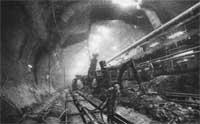Tunnel of the Punched Spot
On 1 December, a French and British worker took his hand on the English Channel. The official celebration will take place on 25 January of this year, with the presence of heads of state François Mitterrand and John Major.
As is known, 50 meters below the seabed of the Mancha three parallel tunnels are being drilled. The central or service section is just finished and the other two train tunnels from Britain and France are expected to be fully drilled this summer. Subsequently, from Paris and London, high-speed trains will begin in the summer of 1883 and the journey between the two capitals will be made in three hours.

In the interior of the tunnel only trains will circulate and carry inside the same cars and trucks. Passengers will travel within their car.
These three parallel tunnels have a length of 50 kilometers, although at the bottom of the sea are 38 kilometers. From the continental point of view, in the town of Sangatte are the beginning of the three holes and the end of the island of Folkestone.
The central tunnel is the one just finished. Brigitte and Robbins (from Sangatt and Folkeston respectively) started working on giant drilling machines for three years. Brigitte is advancing turning the head of almost six meters in diameter. This machine of 250 meters in length, driven by laser, weighed 470 tons. Thanks to the measurements taken by satellite, when the holes on both sides have joined in 50 kilometers the difference between axes has been only 50 centimeters.
As the machines move forward, the hole is protected with concrete rings, totaling a total of 700,000, and weighing forty tons each.
Aside from the seven accidental deaths that occurred in the works, the economic cost has also been increasing. Although the budget was initially 47.000 million francs (850.000 million pesetas), it is expected that the account for the completion of the works will increase to 85,000 million francs (two and a half billion pesetas). In fact, the 28 million passengers expected to travel each year have had to take security measures higher than expected to protect the passengers.





